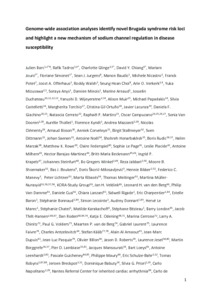Barc, J;
Tadros, R;
Glinge, C;
Chiang, DY;
Jouni, M;
Simonet, F;
Jurgens, SJ;
Baudic, M;
Nicastro, M;
Potet, F;
et al.
Barc, J; Tadros, R; Glinge, C; Chiang, DY; Jouni, M; Simonet, F; Jurgens, SJ; Baudic, M; Nicastro, M; Potet, F; Offerhaus, JA; Walsh, R; Choi, SH; Verkerk, AO; Mizusawa, Y; Anys, S; Minois, D; Arnaud, M; Duchateau, J; Wijeyeratne, YD; Muir, A; Papadakis, M; Castelletti, S; Torchio, M; Ortuño, CG; Lacunza, J; Giachino, DF; Cerrato, N; Martins, RP; Campuzano, O; Van Dooren, S; Thollet, A; Kyndt, F; Mazzanti, A; Clémenty, N; Bisson, A; Corveleyn, A; Stallmeyer, B; Dittmann, S; Saenen, J; Noël, A; Honarbakhsh, S; Rudic, B; Marzak, H; Rowe, MK; Federspiel, C; Le Page, S; Placide, L; Milhem, A; Barajas-Martinez, H; Beckmann, B-M; Krapels, IP; Steinfurt, J; Winkel, BG; Jabbari, R; Shoemaker, MB; Boukens, BJ; Škorić-Milosavljević, D; Bikker, H; Manevy, F; Lichtner, P; Ribasés, M; Meitinger, T; Müller-Nurasyid, M; KORA-Study Group; Veldink, JH; van den Berg, LH; Van Damme, P; Cusi, D; Lanzani, C; Rigade, S; Charpentier, E; Baron, E; Bonnaud, S; Lecointe, S; Donnart, A; Le Marec, H; Chatel, S; Karakachoff, M; Bézieau, S; London, B; Tfelt-Hansen, J; Roden, D; Odening, KE; Cerrone, M; Chinitz, LA; Volders, PG; van de Berg, MP; Laurent, G; Faivre, L; Antzelevitch, C; Kääb, S; Arnaout, AA; Dupuis, J-M; Pasquie, J-L; Billon, O; Roberts, JD; Jesel, L; Borggrefe, M; Lambiase, PD; Mansourati, J; Loeys, B; Leenhardt, A; Guicheney, P; Maury, P; Schulze-Bahr, E; Robyns, T; Breckpot, J; Babuty, D; Priori, SG; Napolitano, C; Nantes Referral Center for inherited cardiac arrhythmia; de Asmundis, C; Brugada, P; Brugada, R; Arbelo, E; Brugada, J; Mabo, P; Behar, N; Giustetto, C; Molina, MS; Gimeno, JR; Hasdemir, C; Schwartz, PJ; Crotti, L; McKeown, PP; Sharma, S; Behr, ER; Haissaguerre, M; Sacher, F; Rooryck, C; Tan, HL; Remme, CA; Postema, PG; Delmar, M; Ellinor, PT; Lubitz, SA; Gourraud, J-B; Tanck, MW; George, AL; MacRae, CA; Burridge, PW; Dina, C; Probst, V; Wilde, AA; Schott, J-J; Redon, R; Bezzina, CR
(2022)
Genome-wide association analyses identify new Brugada syndrome risk loci and highlight a new mechanism of sodium channel regulation in disease susceptibility.
Nat Genet, 54 (3).
pp. 232-239.
ISSN 1546-1718
https://doi.org/10.1038/s41588-021-01007-6
SGUL Authors: Behr, Elijah Raphael
![[img]](https://openaccess.sgul.ac.uk/114152/1.hassmallThumbnailVersion/Barc_edver_1636496586_1_JB20211209.pdf)  Preview |
|
PDF
Accepted Version
Available under License ["licenses_description_publisher" not defined].
Download (499kB)
| Preview
|
Abstract
Brugada syndrome (BrS) is a cardiac arrhythmia disorder associated with sudden death in young adults. With the exception of SCN5A, encoding the cardiac sodium channel NaV1.5, susceptibility genes remain largely unknown. Here we performed a genome-wide association meta-analysis comprising 2,820 unrelated cases with BrS and 10,001 controls, and identified 21 association signals at 12 loci (10 new). Single nucleotide polymorphism (SNP)-heritability estimates indicate a strong polygenic influence. Polygenic risk score analyses based on the 21 susceptibility variants demonstrate varying cumulative contribution of common risk alleles among different patient subgroups, as well as genetic associations with cardiac electrical traits and disorders in the general population. The predominance of cardiac transcription factor loci indicates that transcriptional regulation is a key feature of BrS pathogenesis. Furthermore, functional studies conducted on MAPRE2, encoding the microtubule plus-end binding protein EB2, point to microtubule-related trafficking effects on NaV1.5 expression as a new underlying molecular mechanism. Taken together, these findings broaden our understanding of the genetic architecture of BrS and provide new insights into its molecular underpinnings.
Statistics
Item downloaded times since 02 Mar 2022.
Actions (login required)
 |
Edit Item |



